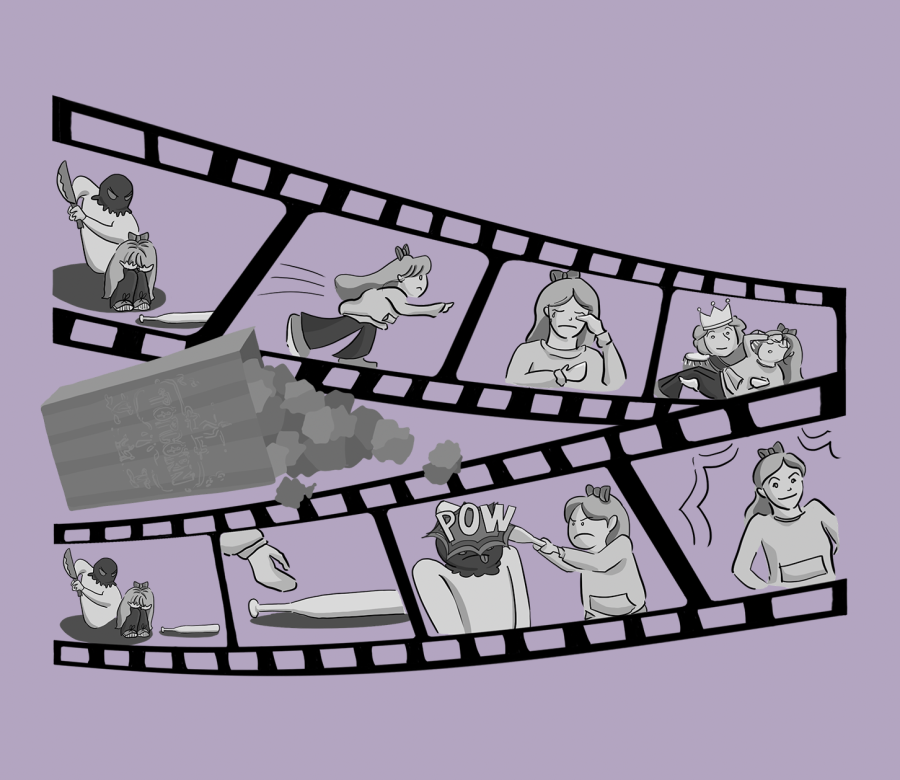Classic Halloween movies contain misogynistic portrayals of women, perpetuate stereotypes
Wendy’s stuck in her bathroom. Her husband is approaching quickly, axe in hand. He hammers down the door with the intent to kill. Screaming and pleading, she is rendered helpless in a corner with no option but to await her fate. She ultimately escapes, still hysteric and heavily scarred. This is a scene from “The Shining,” an iconic horror movie which quickly established itself as a classic. Despite critical praise, the film contains blatantly offensive portrayals of women that clearly do not hold up under modern standards. “The Shining” is not alone in its perpetuation of harmful tropes and stereotypes. Indeed, throughout the horror genre, there is a common theme of women being portrayed as helpless and naive. As Halloween approaches, students turn to horror movies as a way to celebrate the holiday. It is important to acknowledge the offensive portrayal of women in many classic horror movies and recognize how Hollywood has made recent strides to remedy this issue.
When teenagers watch these movies, it is important for them to note that this normalization of women as victims is problematic. It paints them as weak, undermining not only the fictional women on the screen but the real women worldwide as well. Even though these movies are not true stories, the misogyny behind them is very real. It is important for teenagers to realize that these Hollywood classics, which have been acclaimed for decades, are deeply rooted in sexism.
“The Shining,” released in 1980—a period far less forward-thinking than ours—is an excellent example of this deep-rooted misogyny. In the movie, Wendy lives in constant fear of her husband, taking his word as law. This is both before and after her husband Jack starts to descend into insanity. Stephen King himself, the author of the novel the movie is based on, stated during press interviews that “The Shining’s” version of Wendy was in no way accurate to the written description. King’s version paints Wendy as a woman with some level of independence and confidence. By portraying Wendy as weak and timid, the film not only fails to abide by the source material, but also shows how Hollywood tailors its movies to fit the standards of a typical horror film.
“The Shining” is the epitome of a classic Hollywood horror film with derogatory implications for women, as it features a submissive and weak female character left helpless at the hands of an overly dominating male figure. As people view “The Shining” in all its glory, what they are really getting is the portrayal of an abusive relationship with a helpless and uninteresting female protagonist.
The typical girl in distress trope that “The Shining” embodies is in no way the only way misogyny is portrayed in horror films. Another classic, the “Texas Chainsaw Massacre” film series, has its fair share of blatant misogyny. This series of films portrays oversexualized women submitting to the will of ferocious men. In particular the second movie of the series is entirely based on the capture and assault of a woman named Stretch. During her abduction, Stretch is threatened and abused, not only by her two abductors, Leatherface and Chop-Top, but by other male characters. She suffers blows to the head with a sledgehammer and is treated as Leatherface’s possession—as if she has no mind of her own. The only respite she gets is if she makes sexual advances on the men. With Leatherface, for example, she makes him forget about killing her by pleasing him sexually. The fact that her only chances of escaping are through sexual actions sends a troubling message. It implies that women have to use their bodies to get out of precarious situations. It is unfair to underestimate the physical strength of female characters in this way.
In movies where men or younger males get kidnapped, such as “The Black Phone,” the boy gets out due to his own free will and physical prowess. The incapability of women to defend themselves in horror movies serves as a window into how greater, male-dominated Hollywood sees them. Yes, at the end of the movie, Stretch does change the narrative by becoming the one wielding the chainsaw, giving her some power, but the scene in no way redeems the entirety of the film. In fact, the scene looks even more out of place, created as if to fulfill some kind of requirement to check off the feminist box.
Many say that the misogyny in earlier movies led to Hollywood’s shift to more feminist horror. Even the greatest horror movies have flaws, and countless articles have been written about the hidden and not-so-hidden sexism within them. This led to a global conversation about female representation in horror as people began to understand the harm of depicting women this way. Because of these movies and discussions, people are able to recognize that the film industry has not always been a kind place for women. They also argue that these slasher films were able to show a glimpse of what it means to be a woman. A survey by nonprofit Stop Street Harassment found that 81% of women experienced sexual harassment in their lifetimes.
Recently, however, as Hollywood has become more inclusive and begun to portray women as strong, the tide has changed. Now, women are becoming the heroes of their own stories, such as in “Ready or Not,” a 2021 film that follows the story of a woman and her experiences playing a deadly game of hide and seek with her family-in-law. If any member of the family finds her, she will be killed. She takes it upon herself to find a way out of the game without anyone’s help. She demonstrates intelligence and skill, physically as well as mentally, which had not been major strong points of earlier female characters. Another movie, “Jennifer’s Body,” shows a woman who takes control of her life again after going through the traumatic experience of rape. These are only some of the movies that contain strong female leads with powerful stories.
As Halloween approaches, it’s important to note that the horror genre has prejudices about women and their capabilities. While these misogynistic tropes shouldn’t prevent a person from watching their favorite classics, they should be talked about in relation to the place of women not only in horror but in society. So as people enjoy the fall season, revisiting horror movies and hearing Wendy’s desperate cries for help, they should keep in mind that women are strong despite Hollywood’s portrayals.
Your donation will support the student journalists of Henry M. Gunn High School. Your contribution will allow us to purchase equipment and cover our annual website hosting costs.

Senior Lise Desveaux is a centerfold editor for The Oracle and has been on staff since January 2021. Outside of school, she enjoys listening to Taylor...




